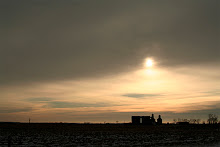



The whole time we have been in Newcastle, WY, the weather has been crappy. Cold, cloudy, light rain, but little wind so we have actually been able to get a lot done. Normally we can spray 12 to 15 miles with our hi-rail truck and then get filled by our water and chemical truck. The hi-rail then continues while the water truck goes and refills with 750 gallons of water. The problem is out here the land is so sparse there are no water locations every 15 miles or so. Try up to 40 miles for water! Tom, the crew leader, came up with a good solution though. Use one of our pickups to meet the hi-rail with 300 gallons of chemical pre-mixed. The extra 300 gallons give just enough time for the water truck to refill and make it to the next location.
The Black Hills sub, originally built by the Chicago, Burlington, and Quincy Railroad, was never built with the intentions of being a heavy mainline. A washboard profile and numerous curves are not good territory to run long, heavy coal trains over. However, with the discovery of vast amounts of coal in the nearby Powder River Basin the line was forced to become a heavy main. CTC signalling, ribbon rail, concrete ties, and a second main (over most of the line) have transformed this line into something else. But the light nature of the old Q is still evident in the grades and curves. If not for the distributed power on nearly every train I couldn't imagine running the huge coal trains over this line! It's pretty amazing.
Something else that is cool is the water in Edgemont, SD. Actually, it's not cool, it's hot. As evidence to the fact that the nearby Black Hills were once a volcano magma near the surface heats up the groundwater so it comes out hot! One of the BNSF carmen said he hasn't turned his hot water heater on in 10 years. It's crazy filling up the tank and watching steam roll out.
Tomorrow we are off for new territory in El Dorado, Kansas, on the BNSF Emporia, La Junta, and Arkansas City subs. Should be an interesting change of scenery.

No comments:
Post a Comment